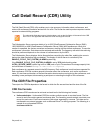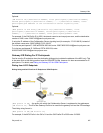
Gateway Calls
Polycom®, Inc. 624
● CDR files are generated for Gateway Sessions in the same way as for conferences.
● Cascading. To support cascading, the gateway indicates a lower number than the MCU for
master-slave relation (directly or through DMA).
● Gateway calls are supported in Microsoft and Avaya environments.
● If the ENABLE_AUTO_EXTENSION system flag is set to:
YES (default), Gateway Calls are not limited in duration while endpoints are connected.
NO, Gateway Calls are limited to 60 minutes.
For more information see Modifying System Flags.
Call Flows
Call flow changes according to the connection protocols: IP or ISDN. This section describes the call flows
between two endpoints connect via one gateway. For call flows describing connections between two
endpoints via two gateways, or a connection of an endpoint to a conference running on MCU via a gateway,
see Basic Cascading Using ISDN Cascaded Link.
IP Participants
The following calling methods are available:
● Direct Dialing - the dialing string includes the destination number/conference ID and the call is routed
directly to the destination endpoint/conference. This is the recommended method.
● Gateway IVR Dialing For IP Participants - the call connects to the gateway, where through interaction
with the IVR, the destination number is entered using DTMF codes.
● Direct Dialing Using IP Addresses - dial and receive calls to and from H.323 endpoints using the IP
address when that the Gatekeeper is not functioning
● Calling a SIP Endpoint in a Remote Domain - connection of H.323 and SIP endpoints residing in one
domain to SIP endpoints residing in a remote domain
Direct Dialing
The calling endpoint enters the dialing string that includes the access numbers to the Collaboration Server
Gateway Profile and the number of the destination endpoint. Up to 10 destination numbers can be entered
in one string.
The call connects to the Collaboration Server Gateway Profile and a Gateway Session is created. The
dial-in participant is automatically connected to it.
During the connection phase, the number being dialed is displayed on the screen of the calling endpoint.
If the call is not answered or it cannot be completed using one communication protocol, the system will try
to connect the endpoint using the next communication protocol according to the selected protocols in the
following order: H.323, SIP and ISDN. PSTN numbers are identified separately and are dialed immediately
without trying other connections.
If the call is busy, the system will not try to connect the endpoint using another protocol.
If the call is not completed after trying all possible protocols, the system displays the number that was dialed
on the calling endpoint’s screen and the reason for not completing the call. For details, see Connection
Indications.


















